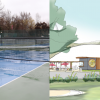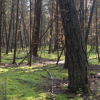As a landslide continues to block the Chilcotin River, scientists are cautioning against a rush to pin the blame on wildfires alone — despite a climate-linked rise in both wildfires and fire-associated landslides in BC.
The landslide reportedly occurred at some point overnight between July 30 and 31 and has since created a built-up reservoir of water that could cause major flooding in the coming days.
Should the dam break, residents along both the Chilcotin and Fraser rivers should be prepared to evacuate, Minister of Emergency Management Bowinn Ma said at a Thursday news conference.

Evacuation orders span 107 square kilometres along the Chilcotin. It is the same place where 19 wildfires merged in 2017, burning an area approximately 130 km across.
Margo Wagner, chair of the Cariboo Regional District, told Canada’s National Observer that the connection between the 2017 wildfires in the area and the landslide that occurred earlier this week is only logical.
“It burned everything,” she said. “When that happens, there is no vegetation that uptakes any water.”
She likened the lack of vegetation in the sandy, silty landscape — followed by an intense thunderstorm — to a sandcastle being washed away at the beach.
“You can't take that much vegetation off of the landscape where there is water flowing, and not expect it to have some results when you're dealing with a sandstone base,” she added.
The connection between wildfires and landslides is well established, but in this case, experts argue that a direct causal link is unlikely.
Dwayne Tannant, a geotechnical engineering professor at the University of British Columbia Okanagan and specialist in geohazards, including landslides, says wildfires were not the dominant cause of the slide. The slope, he said, had been observed to be moving as far back as 1964.
“I'm not saying it's not a contributor. But I don't think it's a dominant cause,” Tannant said.
“You can't just point the finger at that one fire of being a direct correlation to the landslide. It's probably rainfall, it's probably fire. It's certainly geology, and it's the steepness of the terrain, topography and erosion from the river itself. All of those things are conspiring.”
Historical photos of the area show deformation and cracking on the valley wall predating the fire, he adds. Landslides in the region are a recurring event governed more by the valley’s natural rhythms, such as erosion that cuts into the slope of the Chilcotin River itself.
Tannant adds the naturally fragile slope makes the area more susceptible to slides. Thick deposits of fine sand line the steep valley wall, and as moisture seeps into the soil, these sandy slopes weaken over time.
“It was predisposed, it was weakened by past movements,” Tannant said.
When fires set slopes loose
Characteristics common among landslides caused by wildfires are typically smaller-scale, and shallow, surface-level slides not running nearly as deep as the slide at the Chilcotin River, Tannant explains.
Geologist Dan Shugar from the University of Calgary says it’s an easy mistake to make — especially given the province’s history of wildfire-associated landslides.
“This particular landslide, I don't think, has any link to climate change, but we certainly should expect more big landslides as our climate warms and gets wetter,” Shugar said, calling it an “easy logic jump to make, to blame [the slide] on the wildfires.”
In the aftermath of a wildfire, tree root systems deteriorate, which causes slopes to become about half as stable as they were pre-fire, according to a 2018 University of British Columbia study which examined the 2017 Elephant Hill wildfire.
Robert Gray, a wildland fire ecologist, explained why only some landslides in wildfire-affected areas can be attributed to fire: it has to do with the dynamics of land recovery over time.
There are two main reasons for the risk of landslide-associated wildfires lessening over time. The first aspect has to do with vegetation regrowth.
“Anytime we kill vegetation over a large area — trees, shrubs, grasses, herbs — it's the roots of those plants that hold soils in place,” Gray says.
After a wildfire, especially a fire of high severity, many of those root systems rot, and soils give out.
How severely the land burns directly affects how quickly plants grow back, so most often, badly burned sites face the highest risk of slides, says Gray.
The return of water to soils that were immediately water-repelling following wildfires also factors into a wildfire-ravaged landscape’s susceptibility to landslides, he says.
Debris flows often increase for “a few years” after a wildfire, according to a 2015 study. After three-plus years, land recovery lessens this risk.
A growing risk in BC
Landslides are costing billions of dollars in the province. Provincial and federal funds to the tune of over $1 billion went toward repairing damage caused by a series of atmospheric river wash-outs in November 2021, which cut off the Lower Mainland from most major trucking routes.
The largest of these wiped out 130km of the Coquihalla highway, in an area that had seen wildfires. Tannant says the level of destruction was probably amplified because whole watersheds in the area had already been burned, preventing the soil from absorbing the heavy volume of water when the atmospheric river stormed through.
The province’s budget for 2024 also included $405 million over four years in dedicated funds to respond to climate emergencies.
For Gray, re-planting is essential in lessening the risk of landslides in wildfire-affected areas. Once vegetation is reestablished, which often takes a few years, it anchors the soil in place again and diminishes the risk of shallow failures. However, the best way to reduce the risk of landslides post-fire is wildfire prevention, Gray says.
“We have to get out ahead of this problem. We're just reacting to fires, and we have so much to lose if we don't start to mitigate more upfront,” he explained.
About the imminent Chilcotin River landslide, Wagner said the idea of the blockage letting go all at once is her biggest fear.
“My best hope is that the water is going to go over the top and create more of a waterfall effect, and gently erode away the landslide,” she said. “If it lets go in one go, it is millions of litres of water that are going to go down.”
Minister Ma said in a press conference Friday that that’s less likely than a more gentle overtopping scenario.
“Current modelling indicates that an overtopping of the dam is more likely than a sudden release or break of the dam,” Ma said. However, “the impacts could still be significant.”
The precise cause of the Chilcotin landslide is not currently known, Ma said, but the province’s focus is on the slide’s imminent danger.

















